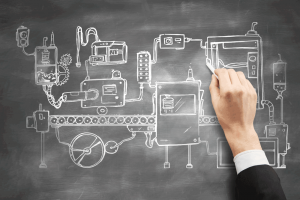The Process of Mechanical Design

A Step-by-Step Look at the Mechanical Design Process
 The design process involves turning a simple idea, based on the needs of consumers, into a complete product that meets these needs. The mechanical design of a product is a sequential process, as the output of one step is the input of the next one.
The design process involves turning a simple idea, based on the needs of consumers, into a complete product that meets these needs. The mechanical design of a product is a sequential process, as the output of one step is the input of the next one.
The process begins with:
Statement of the problem
In this stage, the designer identifies the problem to be solved. This is an essential design stage, because the development of a new product may become time consuming and complicated if the problem wasn’t adequately stated at the very beginning. Stating the problem would help to keep everyone updated and to eliminate potential problems.
Product Design Specification
This is one of the most important stages of the product design process. It is important to understand the actual problem first before coming up with a ‘solution’. The product design specification gives a detailed description of the problem. Seeking the views of potential customers and analysing the market to come up with a requirement list that would generate a successful product is essential.
Concept Design
A conceptual design simply outlines the key components and arrangement of a product without mentioning the specifics. However, the level of detail outlined at this stage would vary according to the product being designed. This stage involves coming up with many different concept designs which correspond to the product requirements, and then choosing the best one after evaluation.
Concept generation
Most mechanical design starts when designers capture their thoughts by sketching and drafting them on a paper. Designers often use mind-mapping, where ideas are generated without giving too much conscious thought, and working from the best basic ideas.
Concept evaluation
After generating many concepts, it is important to choose the best design that would fulfill the requirements as outlined in the product design specification. This task should be performed by a dynamic design team, so that every concept and idea may be evaluated from many angles or perspectives.
Detail design
In this stage, the concept design you have settled on is designed in detail with all the necessary dimensions and specifications included to come up with a detailed drawing of the product design. It may be important to create prototypes to help you understand how the product would look.
Testing
This step may be simple or complicated depending on the product being designed and the potential buyers; a few people test the product and give their feedback or it, can be sent to a testing laboratory for thorough and professional testing.
Manufacturing
Manufacturing is the last step in the mechanical design process. In this step, the designer would look for suitable and relevant manufacturing facilities to make the final product. It’s important to evaluate and consider relevant manufacturing aspects, such as the cost, how long it would take to make them and so on.
Mechanical Design is a very specific skill, so it always helps to talk to a true industry expert! Call RF3 Design Limited to get the ball rolling on the products and mechanics you need.
[button link=”/contact-us/” type=”big” color=”orange”] Get in Touch![/button]

Leave a Reply